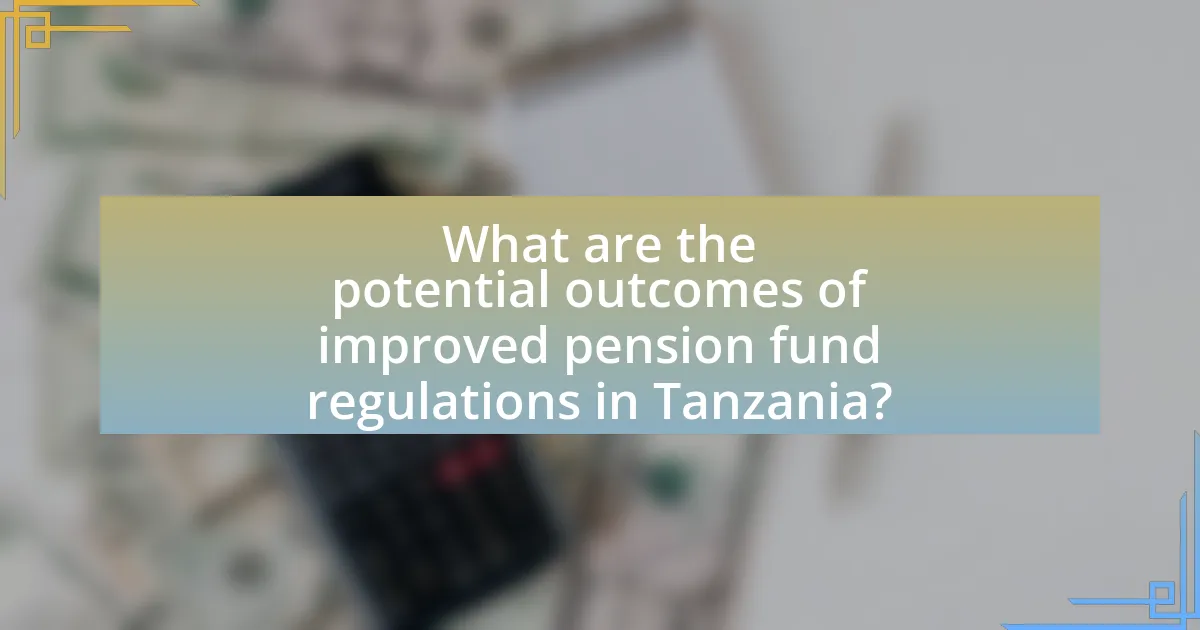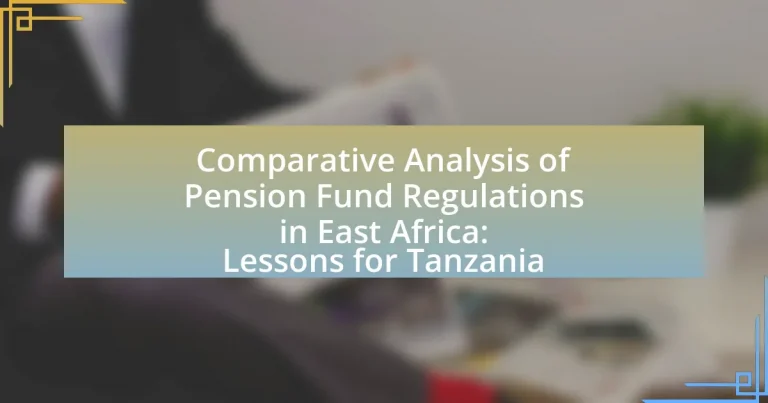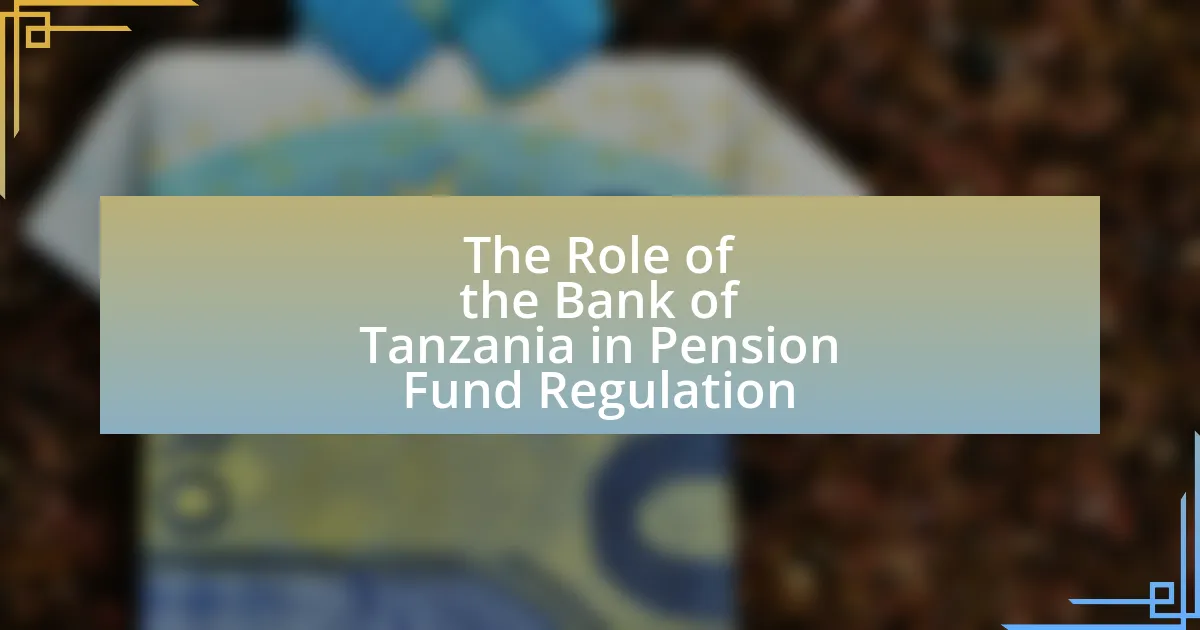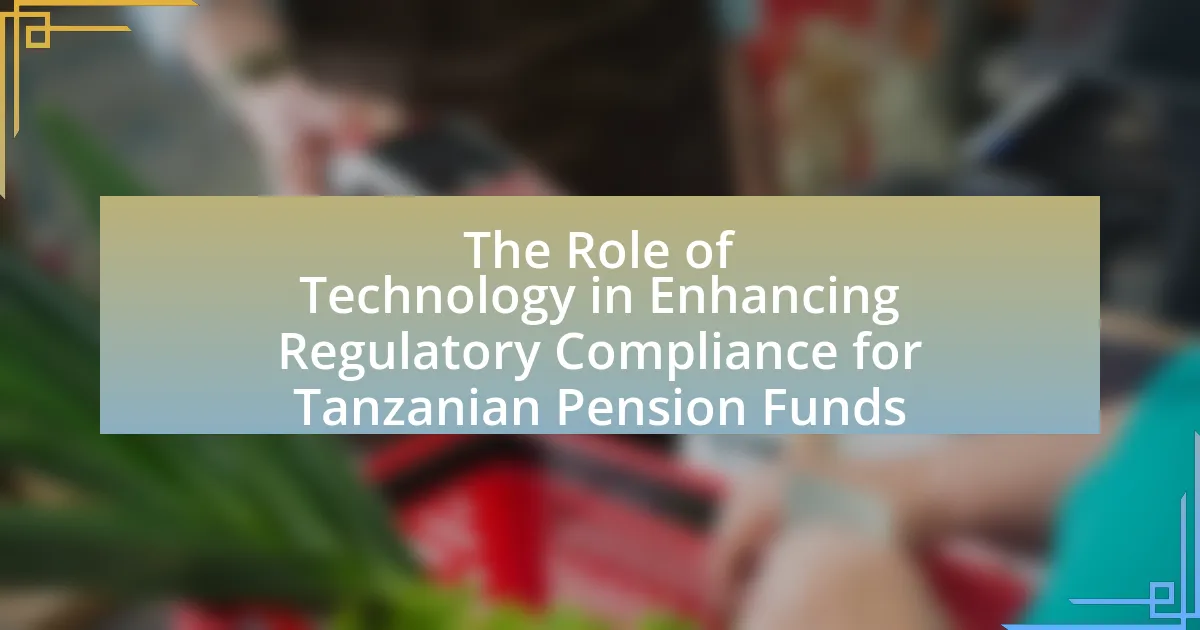The article provides a comparative analysis of pension fund regulations across East Africa, focusing on the unique frameworks established in countries such as Kenya, Uganda, Tanzania, and Rwanda. It highlights key features of these regulations, including mandatory contributions, investment guidelines, and governance structures, which aim to enhance the sustainability and reliability of pension systems. The article also examines the differences in regulatory approaches, particularly between Kenya and Uganda, and discusses the challenges Tanzania faces in reforming its pension fund regulations. Additionally, it outlines potential lessons Tanzania can learn from its neighbors to improve retirement security and economic stability through effective pension fund management.

What are the key features of pension fund regulations in East Africa?
The key features of pension fund regulations in East Africa include mandatory contributions, investment guidelines, and governance structures. Mandatory contributions require both employers and employees to contribute a specified percentage of salaries to pension funds, ensuring a steady inflow of capital. Investment guidelines dictate how pension funds can allocate their assets, often emphasizing diversification and risk management to protect beneficiaries’ interests. Governance structures establish the roles and responsibilities of trustees and regulatory bodies, ensuring transparency and accountability in fund management. These features are designed to enhance the sustainability and reliability of pension systems across the region, as evidenced by the regulatory frameworks established in countries like Kenya, Uganda, and Tanzania.
How do pension fund regulations differ across East African countries?
Pension fund regulations vary significantly across East African countries, reflecting different legal frameworks, governance structures, and investment strategies. For instance, Kenya has a well-established regulatory framework governed by the Retirement Benefits Authority, which mandates minimum funding levels and investment diversification. In contrast, Uganda’s pension system is regulated by the Uganda Retirement Benefits Regulatory Authority, which emphasizes member protection and allows for a broader range of investment options. Tanzania’s pension regulations, overseen by the Pension Funds Act, focus on ensuring the sustainability of funds but have faced challenges in enforcement and compliance. Rwanda’s pension sector is regulated by the National Bank of Rwanda, which has implemented reforms to enhance transparency and efficiency. These differences highlight the unique approaches each country takes in managing pension funds, influenced by their economic conditions and policy priorities.
What specific regulations are in place in Kenya regarding pension funds?
In Kenya, the specific regulations governing pension funds are primarily outlined in the Retirement Benefits Act of 1997, which mandates the establishment and management of pension schemes. This Act requires pension funds to be registered with the Retirement Benefits Authority (RBA), ensuring compliance with standards for governance, investment, and reporting. Additionally, the regulations stipulate that pension funds must maintain a minimum funding level and adhere to investment guidelines that limit exposure to certain asset classes, thereby protecting members’ interests. The RBA also conducts regular audits and assessments to ensure that pension schemes operate within the legal framework, promoting transparency and accountability in the management of pension assets.
How do Uganda’s pension fund regulations compare to those of Kenya?
Uganda’s pension fund regulations are generally more restrictive compared to those of Kenya. In Uganda, the pension sector is regulated by the Uganda Retirement Benefits Regulatory Authority, which mandates that pension funds invest a minimum of 70% of their assets in government securities, limiting investment diversification. Conversely, Kenya’s regulations, governed by the Retirement Benefits Authority, allow for greater flexibility, permitting pension funds to invest up to 30% in alternative assets, including real estate and equities. This difference in investment strategies reflects Kenya’s more liberal approach to pension fund management, which aims to enhance returns for contributors.
What unique aspects characterize Tanzania’s pension fund regulations?
Tanzania’s pension fund regulations are characterized by a mandatory contribution system, where both employers and employees are required to contribute to pension schemes, ensuring a broad coverage of the workforce. Additionally, the regulations emphasize the establishment of a regulatory authority, the Pension Fund Regulatory Authority (PFRA), which oversees compliance and governance of pension funds. Furthermore, Tanzania’s regulations allow for a diverse range of investment options for pension funds, including real estate and infrastructure projects, aimed at enhancing returns for beneficiaries. These unique aspects are designed to promote financial security for retirees while fostering economic development through strategic investments.
Why is it important to analyze pension fund regulations in East Africa?
Analyzing pension fund regulations in East Africa is crucial for understanding the effectiveness and sustainability of retirement systems in the region. This analysis helps identify best practices and regulatory gaps that can impact the financial security of retirees. For instance, a study by the International Labour Organization highlights that effective pension regulations can enhance coverage and adequacy of benefits, which is vital in a region where many individuals rely on pensions as their primary source of income in old age. Furthermore, understanding these regulations allows policymakers to make informed decisions that can improve the overall economic stability and social welfare in East African countries.
What impact do these regulations have on economic stability in the region?
The regulations on pension funds in East Africa significantly enhance economic stability in the region by promoting long-term investment and financial security. These regulations ensure that pension funds are managed prudently, which leads to increased confidence among investors and contributes to a more stable financial environment. For instance, the implementation of stricter governance and transparency standards has been shown to reduce the risk of mismanagement, thereby safeguarding the assets of millions of contributors. Additionally, a study by the International Labour Organization indicates that well-regulated pension systems can lead to higher savings rates, which in turn supports economic growth and stability in the region.
How do pension fund regulations affect the retirement security of citizens?
Pension fund regulations significantly impact the retirement security of citizens by ensuring that funds are managed prudently and that beneficiaries receive adequate payouts. Effective regulations mandate minimum funding levels, investment diversification, and transparency, which collectively safeguard the assets of pension funds. For instance, the International Labour Organization (ILO) emphasizes that well-regulated pension systems can reduce poverty rates among the elderly, as seen in countries with robust pension frameworks. In East Africa, countries with stringent pension regulations have reported higher retirement income security, demonstrating a direct correlation between regulatory strength and citizens’ financial stability in retirement.

What lessons can Tanzania learn from other East African countries?
Tanzania can learn the importance of regulatory frameworks and governance from other East African countries, particularly Kenya and Uganda, which have established more robust pension fund regulations. For instance, Kenya’s Retirement Benefits Authority has implemented strict compliance measures that enhance transparency and protect beneficiaries, leading to a more secure pension system. Uganda’s National Social Security Fund has also adopted innovative investment strategies that have resulted in higher returns for contributors. These examples demonstrate that effective regulation and governance can significantly improve the performance and reliability of pension funds, which Tanzania can adopt to strengthen its own pension system.
How can Tanzania improve its pension fund regulations based on regional practices?
Tanzania can improve its pension fund regulations by adopting best practices from neighboring East African countries, such as Kenya and Uganda, which have established more robust regulatory frameworks. For instance, Kenya’s Retirement Benefits Authority enforces strict compliance and transparency standards, ensuring that pension funds are managed prudently and that beneficiaries receive timely payouts. Additionally, Uganda’s National Social Security Fund has implemented a member-centric approach, allowing for greater participation and feedback from contributors, which enhances accountability. By integrating these practices, Tanzania can enhance the governance, efficiency, and sustainability of its pension system, ultimately benefiting its citizens.
What successful strategies have been implemented in Rwanda’s pension system?
Rwanda’s pension system has successfully implemented several strategies, including the establishment of a mandatory pension scheme for formal sector employees and the promotion of voluntary savings for informal sector workers. The mandatory scheme, initiated in 2003, requires employers to contribute 8% of employees’ salaries, while employees contribute 3%. This has led to increased coverage, with over 90% of formal sector workers enrolled. Additionally, the government has encouraged the growth of private pension funds, which now manage significant assets, contributing to the overall stability and sustainability of the pension system. These strategies have resulted in a more inclusive and robust pension framework, enhancing financial security for Rwandans in retirement.
How can Tanzania adopt best practices from Uganda’s pension fund management?
Tanzania can adopt best practices from Uganda’s pension fund management by implementing a regulatory framework that emphasizes transparency, governance, and investment diversification. Uganda’s National Social Security Fund (NSSF) has successfully enhanced member engagement through regular communication and education, which Tanzania could replicate to improve member awareness and participation. Additionally, Uganda’s approach to diversifying investments across various asset classes has led to higher returns; Tanzania could similarly expand its investment portfolio to include real estate and infrastructure projects, as evidenced by Uganda’s NSSF achieving a 10% annual return on investments over the past decade. By learning from Uganda’s emphasis on strong governance structures, such as independent boards and regular audits, Tanzania can strengthen its pension fund management and ensure better protection of member contributions.
What challenges does Tanzania face in reforming its pension fund regulations?
Tanzania faces significant challenges in reforming its pension fund regulations, primarily due to inadequate regulatory frameworks, limited financial literacy among the population, and insufficient funding mechanisms. The existing regulatory frameworks often lack clarity and enforcement, leading to inefficiencies in pension fund management. Additionally, a large portion of the workforce remains informal, which complicates the collection of contributions and limits the reach of pension schemes. According to the World Bank, only about 10% of the labor force is covered by formal pension schemes, highlighting the need for broader inclusion and education on pension benefits. Furthermore, the government struggles with budget constraints that hinder the establishment of sustainable funding mechanisms for pension reforms. These factors collectively impede the effectiveness of pension fund reforms in Tanzania.
What are the barriers to implementing effective pension reforms in Tanzania?
The barriers to implementing effective pension reforms in Tanzania include inadequate regulatory frameworks, limited financial literacy among the population, and insufficient funding mechanisms. The regulatory frameworks often lack clarity and enforcement, which hampers the establishment of a robust pension system. Additionally, many Tanzanians have low levels of financial literacy, making it difficult for them to understand and engage with pension schemes. Furthermore, the funding mechanisms are often weak, with many pension funds facing liquidity issues and inadequate contributions from both employers and employees. These factors collectively hinder the successful implementation of pension reforms in the country.
How can stakeholder engagement enhance the reform process in Tanzania?
Stakeholder engagement can enhance the reform process in Tanzania by fostering collaboration and ensuring that diverse perspectives are considered in policy-making. Engaging stakeholders, including government agencies, private sector representatives, and civil society organizations, leads to more informed decisions that reflect the needs and priorities of the population. For instance, the involvement of local communities in discussions about pension fund regulations can identify gaps and improve the effectiveness of reforms. Evidence from successful reforms in other East African countries, such as Kenya, demonstrates that inclusive stakeholder participation results in higher compliance rates and better outcomes in pension management.

What are the potential outcomes of improved pension fund regulations in Tanzania?
Improved pension fund regulations in Tanzania can lead to enhanced financial security for retirees. By establishing stricter governance and transparency standards, these regulations can increase trust in pension systems, thereby encouraging higher participation rates among workers. For instance, countries with robust pension regulations, such as Kenya, have seen increased contributions and better fund performance, which can serve as a model for Tanzania. Additionally, improved regulations can facilitate better investment strategies, potentially leading to higher returns on pension funds, which would directly benefit retirees. This is supported by evidence from the World Bank, which indicates that well-regulated pension systems can significantly improve the adequacy of retirement income.
How would enhanced regulations benefit Tanzanian citizens?
Enhanced regulations would benefit Tanzanian citizens by improving the security and efficiency of pension funds. Stronger regulations can ensure that pension funds are managed transparently and responsibly, reducing the risk of mismanagement and fraud. For instance, countries with robust pension regulations, such as Kenya, have seen increased trust in pension systems, leading to higher participation rates among citizens. This trust can result in better financial planning for retirement, ultimately enhancing the quality of life for retirees in Tanzania.
What improvements can be expected in retirement savings for individuals?
Improvements in retirement savings for individuals can be expected through enhanced regulatory frameworks and increased financial literacy. Regulatory reforms in East Africa, particularly in Tanzania, aim to strengthen pension fund management, ensuring better investment strategies and higher returns for contributors. For instance, the introduction of mandatory contributions and diversified investment options can lead to a more robust accumulation of savings. Additionally, educational initiatives that promote understanding of retirement planning can empower individuals to make informed decisions, ultimately increasing their savings rates. These measures are supported by evidence from various studies indicating that improved regulations and financial education correlate with higher retirement savings outcomes.
How might economic growth be stimulated through better pension fund management?
Economic growth can be stimulated through better pension fund management by increasing the efficiency of capital allocation and enhancing investment returns. Improved management practices, such as diversifying investment portfolios and adopting innovative financial instruments, can lead to higher yields on pension funds. For instance, a study by the World Bank indicates that well-managed pension funds can contribute significantly to national savings and investment, which in turn supports economic development. In East Africa, countries that have implemented robust pension regulations have seen an increase in domestic investments, which fosters job creation and infrastructure development, further driving economic growth.
What practical steps can be taken to reform pension fund regulations in Tanzania?
To reform pension fund regulations in Tanzania, the government should implement a comprehensive review of existing laws and policies to identify gaps and inefficiencies. This review can be supported by benchmarking against successful pension systems in other East African countries, such as Kenya and Uganda, which have made strides in enhancing regulatory frameworks.
Additionally, establishing a regulatory body dedicated to overseeing pension funds can ensure compliance and protect beneficiaries’ interests. This body should be empowered to enforce transparency and accountability measures, including regular audits and public reporting of fund performance.
Furthermore, enhancing financial literacy among the population regarding pension schemes can increase participation rates and improve the overall sustainability of the pension system. Evidence from the World Bank indicates that countries with higher financial literacy levels tend to have more robust pension systems.
Lastly, fostering public-private partnerships can attract investment into pension funds, thereby increasing their capacity to provide adequate retirement benefits. This approach has been effective in other regions, demonstrating the potential for improved pension fund performance through diversified investment strategies.
What role do policymakers play in shaping effective pension regulations?
Policymakers play a crucial role in shaping effective pension regulations by establishing the legal framework and guidelines that govern pension systems. They are responsible for creating policies that ensure the sustainability, security, and accessibility of pension funds, which directly impacts the financial well-being of retirees. For instance, in East Africa, policymakers have implemented regulations that require pension funds to maintain certain solvency levels, thereby protecting beneficiaries’ interests. Additionally, they engage in stakeholder consultations to address the diverse needs of the population, ensuring that regulations are inclusive and equitable. This approach is evidenced by the adoption of the East African Community’s harmonized pension guidelines, which aim to enhance cross-border pension portability and improve overall pension system efficiency.
How can public awareness campaigns support pension reform initiatives?
Public awareness campaigns can significantly support pension reform initiatives by educating the public about the importance of pension systems and the need for reform. These campaigns can increase public understanding of pension issues, thereby fostering greater engagement and advocacy for necessary changes. For instance, a study by the International Labour Organization highlights that informed citizens are more likely to participate in discussions and support reforms that enhance pension sustainability and accessibility. By raising awareness, these campaigns can mobilize public opinion, influence policymakers, and ultimately lead to more effective pension reform initiatives.





